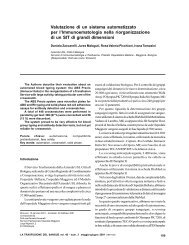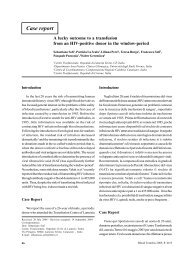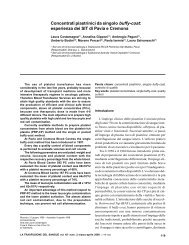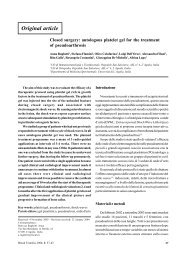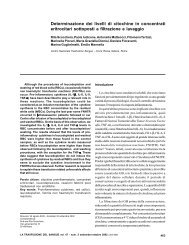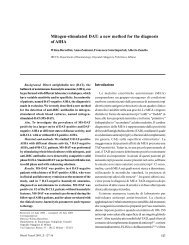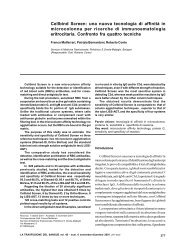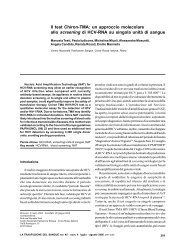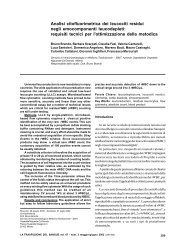Mathematics and transfusion medicine - Blood Transfusion
Mathematics and transfusion medicine - Blood Transfusion
Mathematics and transfusion medicine - Blood Transfusion
You also want an ePaper? Increase the reach of your titles
YUMPU automatically turns print PDFs into web optimized ePapers that Google loves.
REVIEWThe genetics of the Rhesus blood group system*Willy A. FlegelInstitut für Klinische <strong>Transfusion</strong>smedizin und Immungenetik Ulm und Institut für <strong>Transfusion</strong>smedizin,Universitätsklinikum Ulm, GermanyThe Rhesus factor is clinically the most importantprotein-based blood group system. With 49 antigens sofar described, it is the largest of all 29 blood group systems.The unusually large number of Rhesus antigens isattributable to its complex genetic basis. The antigens arelocated on two Rhesus proteins - RhD <strong>and</strong> RhCE - <strong>and</strong> areproduced by differences in their protein sequences. In CDnomenclature, they are termed CD240D <strong>and</strong> CD240CE.Unlike proteins of other blood groups, Rhesus proteinsare expressed only in the membranes of red blood cells <strong>and</strong>their immediate precursors 1 .Rhesus is second in its clinical importance only to theABO blood group. Since the introduction of postpartumanti-D prophylaxis in the late 1960s, <strong>and</strong> combined pre<strong>and</strong>postpartum anti-D prophylaxis in the early 1990s, theincidence of haemolytic disease in newborns due toalloimmunization has been reduced by more than 90%. Upto 1% of all pregnant women have clinically significantanti-erythrocyte antibodies 2,3 .Anti-D remains the main indication for phototherapyor exchange <strong>transfusion</strong>s in newborns 2,4 , <strong>and</strong> pregnantwomen who are D negative show an above averageincidence.The five most important Rhesus antigens are the causeof most alloimmunizations following blood <strong>transfusion</strong>.According to the German haemotherapy guidelines[Richtlinien zur Gewinnung von Blut undBlutbest<strong>and</strong>teilen und zur Anwendung vonBlutprodukten] 5 , D negative <strong>transfusion</strong> recipients mustalways be given D negative erythrocyte products.Since 2000, women of reproductive age <strong>and</strong> girls havealso received <strong>transfusion</strong>s compatible for further Rhesusantigens such as C, c, E <strong>and</strong> e in addition to the K antigenof the Kell blood group 5 .This procedure also applies to patients who receiveregular <strong>transfusion</strong>s or have immunohaematological50problems, like anti-erythrocyte allo- <strong>and</strong> autoantibodies.In the case of autoantibodies, their exact specificity is notusually determined. Although one thirds of suchautoantibodies are directed at Rhesus proteins, this hasvirtually no practical consequences for treatment 1 .The D antigen, discovered in 1939, was the first Rhesusantigen to be described. D positive patients were termedRhesus-positive. In 1946, a quantitative variant with aweakly expressed D antigen was discovered <strong>and</strong> termed"D u ". This variant, now called "weak D", is of clinical <strong>and</strong>diagnostic importance.Since 1953, is has been clear that there are alsoqualitative variants of the D antigen. Although patientswith this partial D variant are positive for the D antigen,they can also form anti-D.The genetic basisIn order to underst<strong>and</strong> the genetic basis of diseases, itis important to underst<strong>and</strong> individual differences in geneticvariability, as well as their frequency <strong>and</strong> distribution inthe population 6 . There is usually a close correlation betweenthe genotype <strong>and</strong> the expressed phenotype. Thus, takinga change in the RHD gene as an example, it is possible tomake inferences about the expression of the RhD proteinin the erythrocyte membrane. As is the case with many Dvariants, modified RhD protein can have importantimplications for <strong>transfusion</strong> related antigenicity.The molecular basis of the RH allelesThe first Rhesus gene, the RHCE gene, was discoveredin 1990. The RHD gene was found two years later, <strong>and</strong> thetotal deletion of this gene ascertained as the cause of theEuropean D negative phenotype.*Part of this review was presented by the Author during the XXXIX SIMTI Congress(Paestum, SA, 4-7 October, 2006)<strong>Blood</strong> Transfus 2007; 5: 50-57© SIMTI Servizi Srl050-57_flegel.p65 5005/07/2007, 10.34



